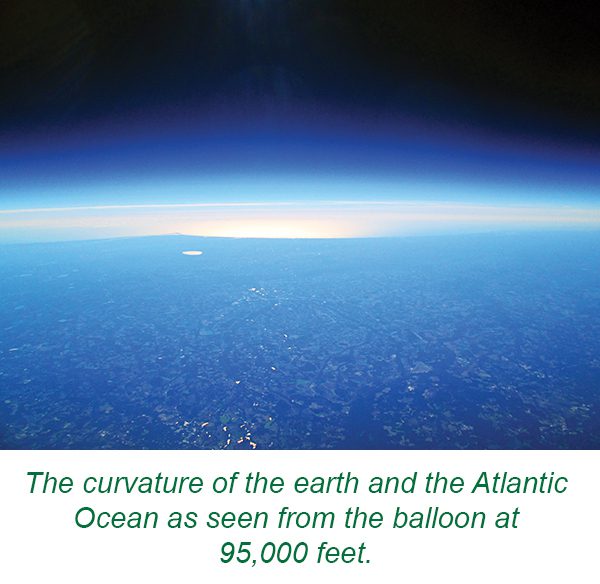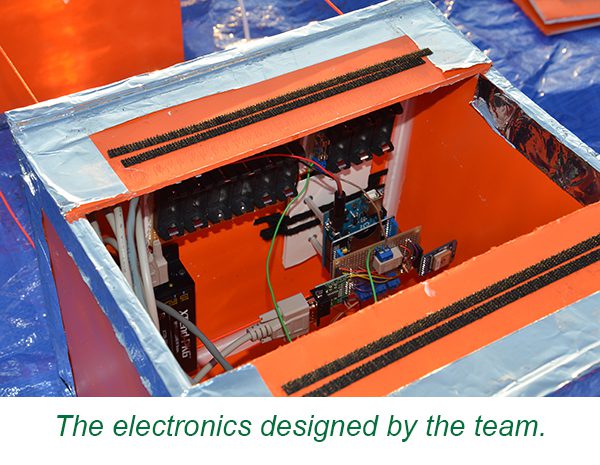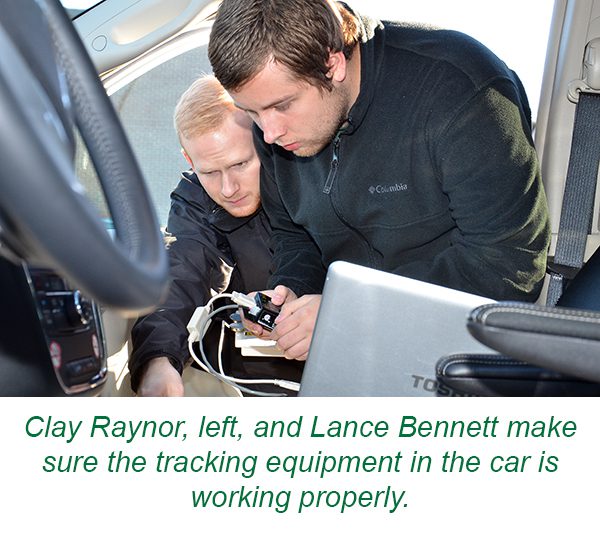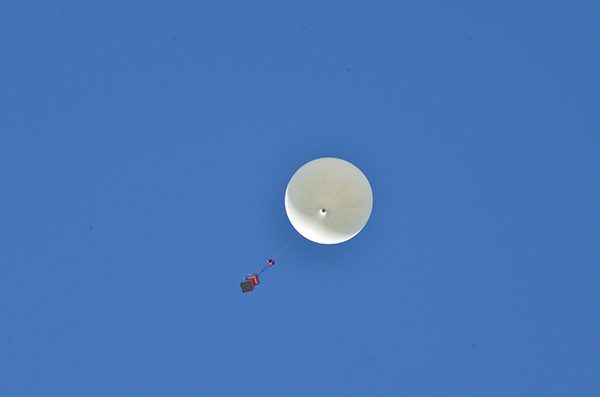Near-Space Balloon Project Brings Challenges of Earth and Space
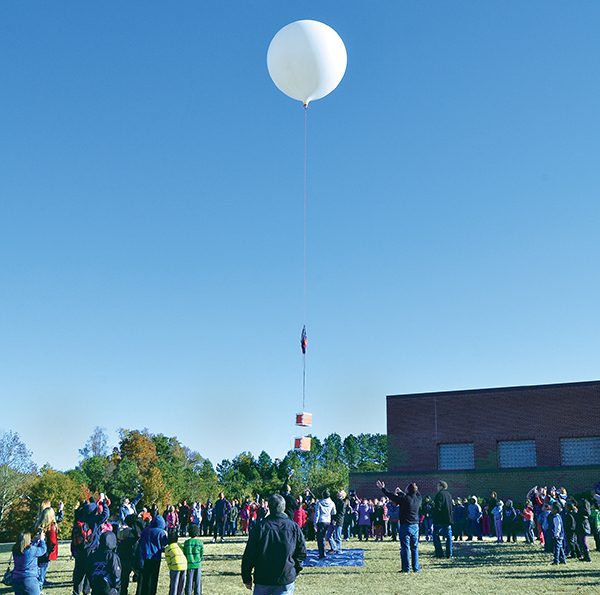
Designing, building and testing data systems for a balloon that flew into the stratosphere brought challenges of operating in the environments of both space and of earth. Nearing the edge of the atmosphere, the challenges were thin air, dramatically cold temperatures, low pressure and high winds. Back on earth challenges included tracking the balloon, doing calculations to keep it out of the ocean, finding a willing fire department to retrieve the balloon from a tree and relying on the good will of a chicken farmer to return the balloon from his property.

Taking on challenges of the NASA Near-Space Balloon Project was the senior design team of Lance Bennett, computer engineering, Ryan Alexander, mechanical engineering technology, Clay Raynor, electrical engineering, and Chris Boehm, mechanical engineering. The goal of the team was to launch a balloon that would reach the stratosphere at least 17 miles up. The balloon would carry two capsules containing data collection devices, cameras and GPS tracking systems that would operate autonomously and transmit data back to earth in real-time.
“Our tasks were to record temperature, pressure and altitude at set time increments,” Raynor said, “and transmit all the information back to ourselves. The work involved programming microcontrollers, embedding GPS into the systems, controlling the cameras and designing a radio system and antennas to transmit and receive the data.”
The team’s first launch was in early October. All the systems worked initially, but the GoPro video camera malfunctioned at 40,000 feet. There were also problems with one of the GPS systems. The second GPS continued to function, so the team was able to continuing tracking the balloon. Returning to earth on a parachute, the balloon capsules landed 60 feet up in a tree in Cheraw, South Carolina.
“We tried throwing a weight tied to a line over everything to retrieve it, but we had no luck,” Boehm said. “So we got hold of the local fire department and they came out and got it down for us.”
The team then went to work analyzing what went wrong and fixing it. Bennett had the task of coding the Arduino microcontroller, which is essentially a small low-power computer that can receive input from a variety of sensors and then send control signals based on those inputs.

“We were able to debug everything for the second flight,” Bennett said. “We got the Arduino properly controlling the data systems.”
For the second launch, the team went to Mallard Creek Elementary School in Charlotte. “The purpose of doing the launch at the school was to hopefully get the kids interested in STEM fields,” Bennett said. “I think we put on a good show for them. For us it was great having a cheering crowd yelling out the countdown.”
Weather conditions were much different for the second launch. A computer program that predicts the flight path of the balloon showed it might fly all the way to the Atlantic Ocean. To make sure this didn’t happen, the team increased the amount of helium in the balloon. More helium means the balloon bursts at a lower altitude, so it is in the air less time and doesn’t travel as far down range.
“The way the balloon works is there is pressure on the inside from the helium,” Raynor said. “As the balloon gets higher and higher, the atmosphere gets thinner and the pressure on the outside of the balloon gets smaller. So, eventually the balloon bursts and the payload falls back to earth on the parachute. We were afraid the balloon would go out over the ocean, so we put in more helium to make it burst earlier.”
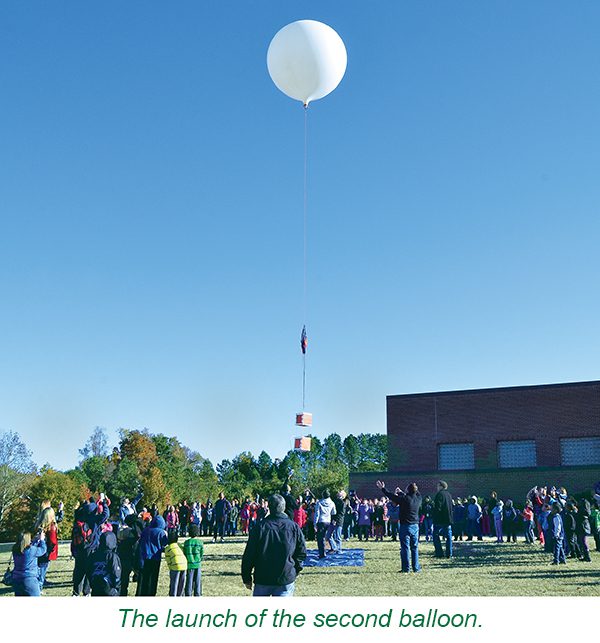
The second flight went perfectly, with the balloon reaching 95,500 feet, which is 18 miles. All systems worked on the ascent, and transmissions were sent every 10 seconds to the team who was tracking the balloon in a car. At the time of the balloon burst, there was some damaged and some wire connections broken. The GPS signals continued, though, and the team again went looking for where the parachute had landed.
This time the parachute ended up in a chicken farm in Wade, North Carolina, which is near Fayetteville. “My name and contact information was on the side of one of the capsules,” Boehm. “We got a call from a farmer saying he had the balloon. He didn’t really want us on his property, though, so he brought everything out to us.”
The photos and video from the balloon at the edge of space came out beautifully. The curve of the earth, the Atlantic Ocean and Wilmington can all be seen. The footage of the balloon falling rapidly through the stratosphere, where the air is too thin have much effect on the parachute, is dramatic.
“The project was kind of an adventure,” Bennett said. “Especially chasing it around the countryside.”
Getting the many components of the project to work together was a real achievement. “With such an interdisciplinary team it was great to see everything all come together and work like it was supposed to,” Alexander said.
A video of the explosion of the second balloon and it’s fall back to earth is here.
For more information on the project contact Dr. Jonathan Bird.
